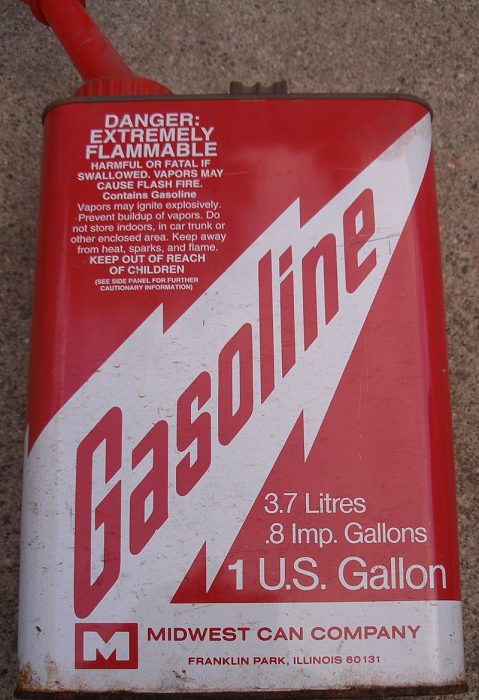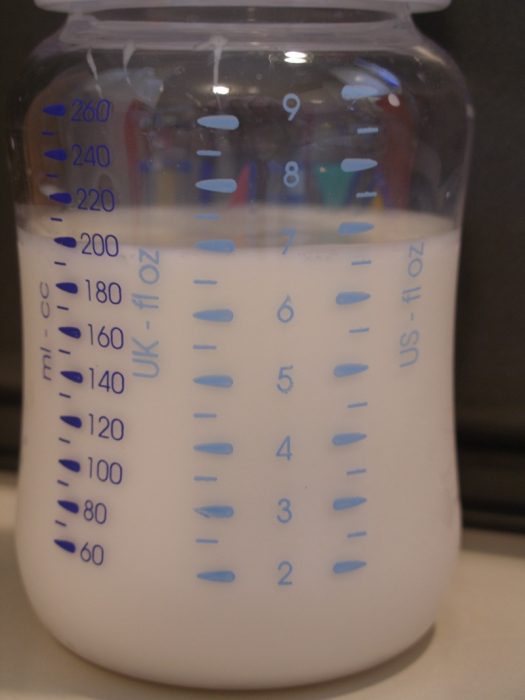
Are you curious how many quarts are in a gallon? There are 4 quarts within a gallon, which makes sense when you consider that the term quarter refers to a fourth of something. There are also two pints in a quart and two cups in a pint.
However, when discussing how many quarts are in a gallon, and determining the amount of volume in a court or gallon, it is important to define what kind of quart you’re referring to. There are multiple kinds of quarts: there is the imperial quart (in the British imperial system) and there is both a dry quart and a liquid quart in the US customary system of measurement.
Let’s examine the different ways that both quarts and gallons are defined in different systems of measurements.
Definition Of Quarts

There are two pints in a quart. Photo: By Louiseldon – Own work, CC BY-SA 4.0, https://commons.wikimedia.org/w/index.php?curid=65734908
A quart is a unit of measurement under the English measurement system. There are three different forms of quarts currently in use: the dry court and the liquid court in the US measurement system and the Imperial court in the British Imperial system of measurement. The term “quart” comes from the French word quart (though the French word quart may be used to mean something else, and the Canadian French language has its own term for a quart – a pinte.) The volumes for these different quarts are approximately equivalent to one metric liter. However, there are slight differences in how these quarts are measured.
The US system of measurement has specified legally standardized measures for both the volume and length of units. Inches, feet, and miles have their own measurements that are apart from the metric system of measurement, but they have metric equivalents for area and volume. For this reason, the liquid quart can be defined as either 57.75 cubic inches or 0.946352946 liters. There are historical references to a US dry quart, and though it seems to be rarely used today it is defined as being equal to exactly 1/4th of a dry gallon or as 1.10122 liters.
The British imperial measurement system, though based on English units like the US system, has different standards for units like cups, pints, quarts, gallons, inches, and feet.
There were other types of quarts that existed throughout history but are now defunct. One such archaic measure is a Winchester quart, which is approximately equal to 2.25 liters or 2 imperial quarts. While very rarely used, laboratory chemicals sometimes come in 2.5-liter bottles referred to as Winchester quart bottles. A reputed quart is roughly equivalent to 1/6th of an Imperial gallon, around 0.75 liters, of 2/3rds of an Imperial quart. The reputed quart was at one time used to serve as the basic size of a wine bottle within the UK, but the current wine bottle standard volume is 0.75 liters.
Definition Of Gallon
The gallon is a unit of volume measurement in both the British Imperial system and US custom systems of measurement. Much like how there is a wet quart and a dry quart in the US measurement system, there’s also a US dry gallon and a US wet gallon. Beyond this, the Imperial gallon has its own definition. The US dry gallon and the US liquid gallon are used mainly throughout the United States, but they are also used by some Caribbean countries and Latin American countries, though typically only when selling gasoline. The Imperial gallon still sees use in Canada, the United Kingdom, and some nations in the Caribbean sea.
Currently, the Imperial gallon is defined as being equivalent to 4.56 liters, and it is used within Commonwealth countries. Commonwealth countries are those that Belong to the Commonwealth of Nations, a political Association of loosely connected nations membrane over 50 nations total. Most of these countries were countries that were part of the British Empire at some point in history. India, Australia, different nations in Africa, Canada, and of course Great Britain are members of the Commonwealth of Nations. You can also define the Imperial gallon in terms of ounces, as there are 160 fluid ounces in an imperial gallon.
In the United States, the wet gallon or liquid gallon is defined as being equivalent to 231 in.³ or approximately 3.785 L. In terms of weight, this is about 3.78 kg or 8.34 pounds. Much like the Imperial gallon, the volume can also be given in US ounces. There are 128 US fluid ounces in a US gallon, and there are 4 quarts within the US gallon, 2 pints to a quart, and 2 cups or 16 fluid ounces in a pint. The US dry gallon is considered to be equivalent to 268.80 cubic inches or about 4.40 liters. The dry gallon is also equivalent to 1/8th of a Winchester bushel, an extension of the Winchester measurement system mentioned above. The dry gallon isn’t relevant in most situations and it is not used in commerce.

Photo: By MJCdetroit – Own work, CC BY 3.0, https://commons.wikimedia.org/w/index.php?curid=4267666
Most countries in the world utilize the liter to do volume calculations. Although the liter isn’t recognized by the International System of Measurements, the ISM’s system of prefixes can be used alongside liters very easily and the ISM also accepts liters as legitimate units for calculating volume. The milliliter is the most frequently used unit of measurement, though other liter based measurements – such as the deciliter and hectoliter – are occasionally used.
Most of the world uses liters when calculating the volume, though as previously mentioned various Caribbean nations, Canada and the United Kingdom use the Imperial gallon. The Imperial gallon is also used as a unit of measurement in countries such as Antigua and Barbuda, the Bahamas, the British Virgin Islands, Dominica, St. Lucia, and Montserrat. The US standard gallon is somewhat more widely used than the Imperial gallon, with countries like the Dominican Republic, Ecuador, El Salvador, Guatemala, Columbia, Peru, Nicaragua, and Honduras continuing to utilize the US gallon alongside the United States. Once more, however, this is typically only done when selling gasoline.
Differences Between Imperial Measurements And US Customary Measurements
The Imperial system and the US customary system are similar to one another in many respects, with units like the cubic mile, cubic foot, and cubic inch being essentially the same. There are a few minor differences between these units of distance, but they can typically be used interchangeably. Some differences between the Imperial system and US customary system regarding distance include the fact that in the US system the survey mile and survey foot are separate units with their own values. The reason that the survey foot and survey mile have their own definitions is that otherwise, measurements made by US surveyors would accumulate errors over time. For instance, the US system sets 1 m as being equivalent to 39.37 inches while the international foot is equivalent to the are .3048 m. These differences must be accounted for otherwise every mile would see an error accumulation of approximately 3.2 mm.

Photo: By MJCdetroit at the English Wikipedia, CC BY-SA 3.0, https://commons.wikimedia.org/w/index.php?curid=46934124
Units of volume can be substantially different between the Imperial system in the US customary system. As an example, with the difference between the US fluid gallon and the Imperial gallon being just one example. While the Imperial gallon is equivalent to 4.5460 L, the US gallon is equivalent to 3.785 L or 231 in.³. Meanwhile, the Imperial pint is equivalent to 568.26 mL while the US liquid pint is equivalent to 473.176 mL
Yet another difference is in volume between the Imperial system and the US standard system is how Canadian and American brewers measure their beer. Fluid ounces are used to measure beer under both systems, but the volumes are different. Canadian brewers make use of the Imperial fluid ounce, which is approximately equivalent to 341 mL while the United States uses the US customary, and under it beers are 12 fluid ounces or about 355 mL.
Converting Between Quarts/Gallons And Milliliters
It’s quite simple to convert between quarts and gallons. Since quarts are just one-quarter of a gallon, all you have to do is divide the number of quarts by 4 (or multiply the value by 0.25) in order to find out how many gallons you have. In order to convert between gallons and quarts, just do the opposite calculation and divide the number of gallons by 4.
What about converting between quarts and milliliters? This is quite a bit trickier than converting between quarts and gallons since 1 quart is equal to approximately 946.353 milliliters for a US quart. If you are using the imperial quart it is equivalent to 1136.52 milliliters instead. Just multiply the number of quarts by either 946.53 or 1136.52 depending on which quart you are using. The values are different for the two different quarts, so be sure you use the same value consistently and don’t accidentally start using the wrong quart when doing calculations.
The process of converting between the gallon and milliliters is essentially the same as converting between quarts and milliliters, except you multiply the number of gallons by 3785.41 for the US gallon and by 4546 for the Imperial gallon. Finally, since there are 1000 millimeters in a liter, you can divide these numbers by 1000 to ascertain how many liters you have.








